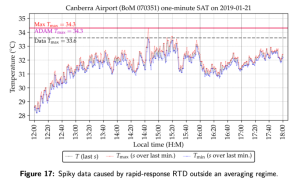
Averaging by its very nature smooths: removing peaks and troughs. Temperature data tends to be cyclical, whether on a one-minute, or thousand-year scale. The Australian Bureau of Meteorology has made a habit of smoothing when it is convenient and using extreme values otherwise. Take their one-minute temperature data from Canberra Airport: super-sensitive electronic equipment now records the highest, lowest, and last second of each minute and reports the highest second as the daily maximum temperature. Back in 2019 I purchased some of this data to test the Bureau’s claim that averaging the data would make no difference. I found that averaging the last one-second of each minute always gave me a lower maximum temperature. This is because the difference between the the highest and the last second could typically be 0.7 degrees Celsius as shown in Figure 17 – that is from a comprehensive report I co-authored in 2020. I have so far been unable to get this report published in a suitable peer-reviewed journal perhaps because it contradicts the Bureau’s much lauded Ayers and Warne (2020) analysis that comes to the opposite conclusion.
https://jennifermarohasy.com/2023/05/averaging-last-seconds-versus-bureau-peer-review/
